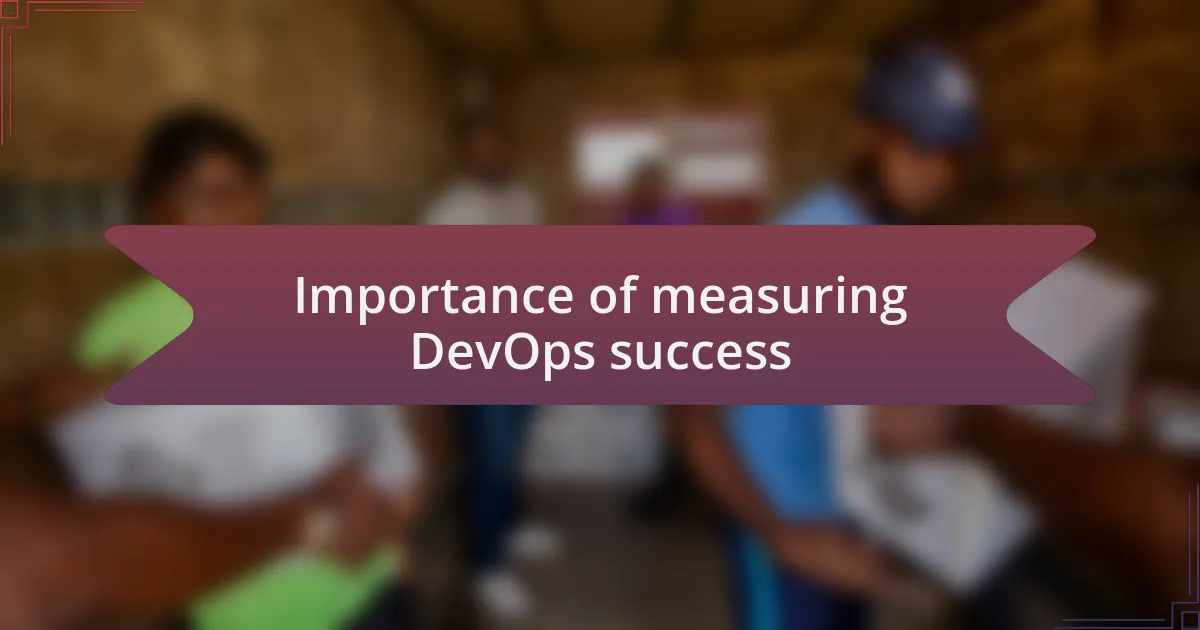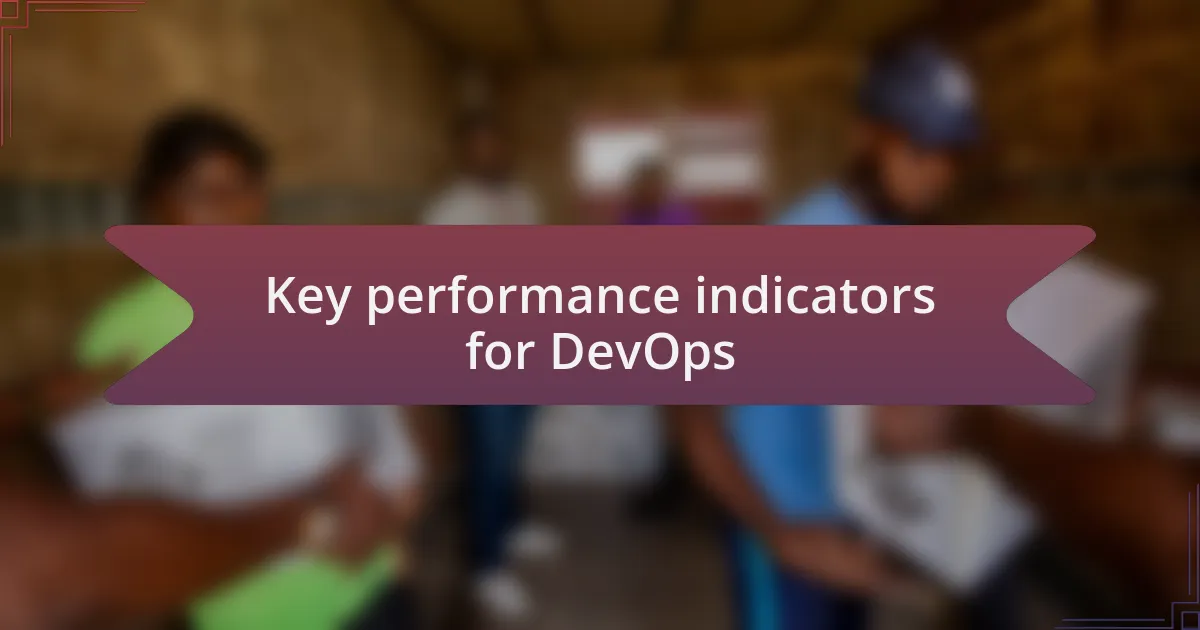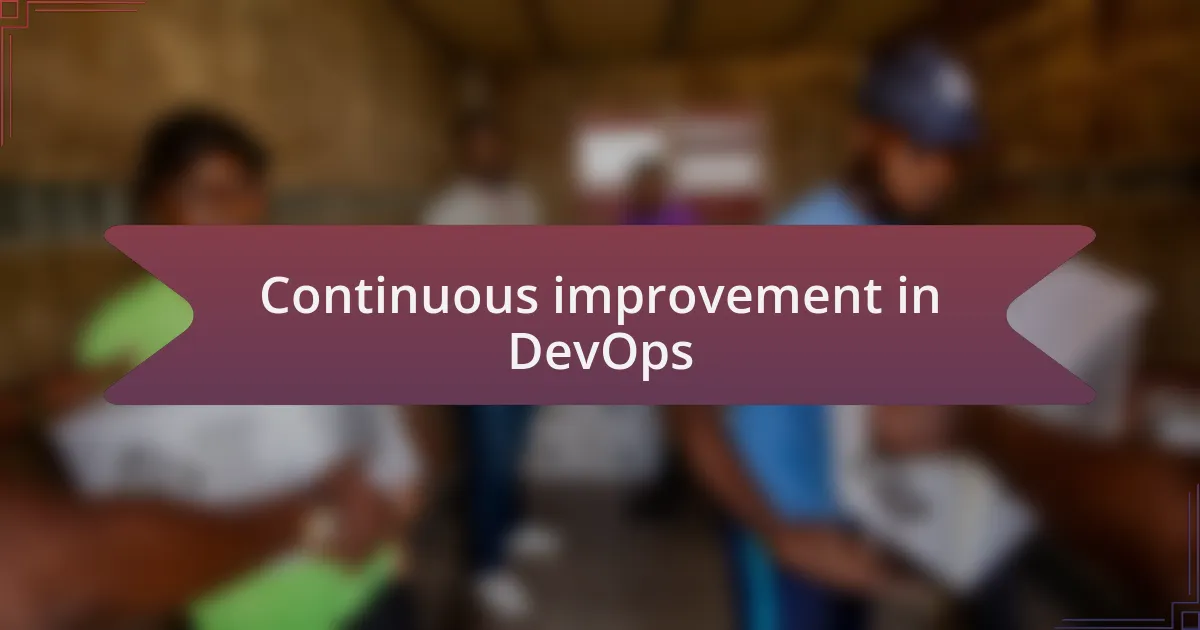Key takeaways:
- Key metrics for measuring DevOps success include deployment frequency, lead time for changes, and mean time to recovery (MTTR), which help to identify areas for improvement.
- Implementing tools like Grafana, Prometheus, and Jenkins enhances visibility and enables real-time tracking of performance metrics, fostering a data-driven culture.
- Regular retrospective meetings and feedback loops promote continuous improvement by celebrating successes and learning from challenges.
- Real-life case studies demonstrate that adopting a metrics-driven approach can lead to significant improvements in deployment processes and team morale.

Understanding DevOps success metrics
When it comes to measuring DevOps success, I’ve found that focusing on a few key metrics can make all the difference. For instance, tracking deployment frequency helps me understand how often we deliver new features to our users, and this insight motivates the team. Have you ever realized how uplifting it is to see your hard work materialize so frequently?
Another crucial metric I’ve encountered is lead time for changes. This tells me how quickly we can get from code commit to production. In my experience, reducing this lead time not only enhances efficiency but also boosts team morale as we celebrate faster iterations. It’s fascinating how these numbers can reflect our efforts and dedication.
Lastly, I’ve learned that monitoring mean time to recovery (MTTR) is essential for understanding our ability to respond to incidents. When a deployment goes wrong, how quickly can we rectify the situation? My team’s swift recovery from issues instills a sense of confidence not only in our ability to resolve problems but also in our overall DevOps practices. Relating these metrics to real-life outcomes has truly illuminated their value for me.

Importance of measuring DevOps success
Measuring DevOps success is critical for understanding where we stand and where we need to go. When I first started tracking our deployment success rate, it was an eye-opener. I remember feeling a mix of surprise and pride as I realized we were deploying more frequently than I had initially thought, which not only helped us pivot quickly but also fostered a culture of innovation within the team. How could we take pride in our progress without these tangible benchmarks?
In my experience, the act of measuring transforms vague achievements into clear goals. I still recall a project where poor visibility into our MTTR led to frustration during a major incident. After we began tracking this metric, we learned to prioritize post-mortems, which improved our response times. It made me wonder—how many teams overlook this simple yet powerful insight? Recognizing these patterns has undeniably spurred me to cultivate resilience in my team’s approach to challenges.
Furthermore, measuring success in DevOps cultivates a shared sense of accountability. I’ve seen that when each team member understands how their contributions influence our metrics, it fosters a deeper sense of ownership. I remember how excited I felt when a colleague acknowledged how their quick fixes not only improved our MTTR but also led to fewer downtime incidents. Isn’t it incredible to witness the direct impact of your work on the organization’s success?

Key performance indicators for DevOps
Key performance indicators, or KPIs, are essential for gauging DevOps success. One KPI I found particularly illuminating is the deployment frequency. Initially, I thought our deployment rhythm was sporadic at best. However, once we started tracking it, I was amazed to see how consistently we deployed. This realization not only boosted our team’s morale but also highlighted the importance of continuous delivery in our overall strategy. Wouldn’t you agree that knowing how often we release can drive our commitment to improvement?
Another invaluable metric is the mean time to recovery (MTTR). When I first began analyzing MTTR, I experienced a mix of anxiety and determination. There were moments when our recovery times were dishearteningly slow, prompting us to reflect on our processes. After implementing more rigorous tracking, it was rewarding to witness our responsiveness improve. This not only built confidence within the team but also reinforced a proactive approach to incident management. Isn’t it fascinating how numbers can shape our strategies in such profound ways?
Lastly, I’ve learned the importance of measuring change failure rate. At first, I was hesitant to confront this particular statistic, as it can reveal uncomfortable truths. Yet, by facing these numbers head-on, we could identify areas needing improvement. I’ll never forget the discussion that arose from one particularly high failure rate; it led to collective brainstorming sessions that transformed our strategies. It made me wonder—how many teams shy away from these metrics, missing opportunities for growth? Embracing these challenges is a vital step in nurturing a culture of continuous improvement.
![]()
Tools for tracking DevOps metrics
When it comes to tracking DevOps metrics, I’ve found that tools like Grafana and Prometheus can dramatically improve visibility. I remember introducing Grafana to our team, and it felt like flipping a switch; suddenly, we were presented with real-time data that made discussions more concrete and actionable. Hasn’t it been a game-changer to visualize data rather than simply discussing it in abstract terms?
Another noteworthy tool is Jenkins, which I initially viewed as just a Continuous Integration (CI) solution. However, as I delved deeper, I discovered its powerful plugin ecosystem for metrics tracking. Using Jenkins, I could integrate various KPIs directly into our build pipeline, streamlining our performance assessments. I still marvel at how integrating metrics with our CI/CD process seemed to unveil patterns in our deployment successes and failures, challenging me to constantly seek improvement.
I also can’t overlook the importance of integrating Slack or Microsoft Teams with these tools for real-time notifications. I recall a crucial incident where an automated alert from our metrics tool prompted us to address a deployment issue before it escalated. This immediate feedback loop made me think—how many issues could we preemptively resolve by harnessing such integrations? It’s truly an enlightening experience to see how the right tools can make metrics not just numbers, but vital signals guiding our DevOps journey.

My methodology for measuring success
To measure success effectively, I focus on three core areas: deployment frequency, lead time for changes, and mean time to recovery (MTTR). I vividly recall a project where we improved our deployment frequency by automating our deployment processes, which not only boosted team morale but also demonstrated tangible results in user satisfaction. Have you ever noticed how often a small tweak can enhance overall performance?
Analyzing lead time has also been enlightening. I remember one sprint where we reduced our lead time to just a couple of days, which felt like a victory not only for our team but also for stakeholders eagerly awaiting new features. This shift taught me how essential it is to keep the flow of changes steady; it’s like keeping the rhythm of a well-tuned orchestra, where every note matters.
Finally, I regularly evaluate MTTR as a critical metric for success. One incident stands out when we faced a major outage, and our quick recovery response made all the difference. This experience reinforced my belief that efficient recovery processes are not just about metrics—they reflect the resilience built within the team. Isn’t it satisfying to turn challenges into opportunities for growth?

Continuous improvement in DevOps
Continuous improvement in DevOps requires a commitment to learning from every project and iteration. I vividly remember a time when our team adopted regular retrospectives after each sprint. These sessions weren’t just about identifying what went wrong; they also celebrated our wins. Reflecting on our successes built up a sense of camaraderie and motivation that I hadn’t expected. Have you ever felt how sharing those victories can really uplift a team’s spirit?
One particular process that has transformed our approach is the emphasis on feedback loops. Early in my career, we underestimated the value of input from all team members. By fostering a culture of open communication, I witnessed our project outcomes improve significantly. It’s like planting seeds in a garden and watching them flourish—each voice contributes to a more robust outcome.
I also recall experimenting with automation tools that streamlined our workflows. Initially, there was resistance to change; many were apprehensive about the learning curve. But once we embraced the tools and saw the time saved, the shift was palpable. It’s moments like these that confirm how vital continuous improvement is in DevOps. What have you experienced in your journey that transformed your perspective?

Real-life case studies of success
One of the most impactful case studies I encountered involved a mid-sized tech firm that struggled with deployment delays. They began implementing continuous integration (CI) practices, which fundamentally changed the way they operated. I remember the excitement in their team’s meetings when they rolled out changes to production daily, significantly reducing the time between development and launch. Hasn’t it been fascinating to see how quickly a process can evolve with just the right tools?
Another compelling success story comes from a large financial institution that incorporated DevOps practices to enhance their software security. They adopted a shift-left approach, integrating security testing early in their development cycle. I recall how the developers initially viewed this as an added burden, but once they recognized that it reduced vulnerabilities and saved time later on, their enthusiasm shifted dramatically. Isn’t it remarkable how aligning security with development can turn a challenge into an opportunity for growth?
Lastly, a small startup I worked with saw impressive results after adopting a metrics-driven approach to measure their DevOps success. By tracking key performance indicators (KPIs) like deployment frequency and mean time to recovery (MTTR), they gained invaluable insights into their processes. I distinctly remember their delight when they observed a 40% reduction in recovery time after implementing targeted changes. What if every team applied such metrics to understand their own performance? The enlightenment it can bring is profound.